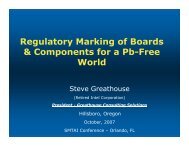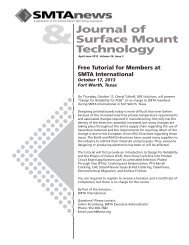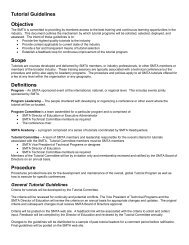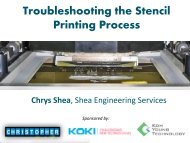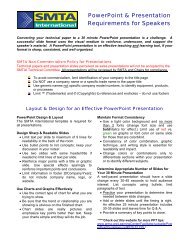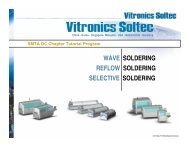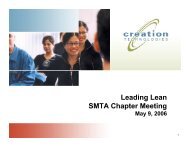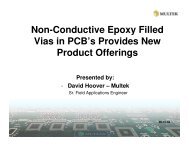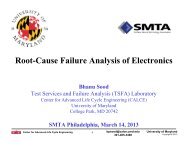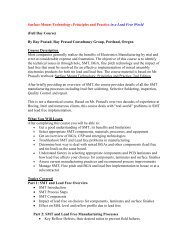BGA Reliability Enhancement - SMTA
BGA Reliability Enhancement - SMTA
BGA Reliability Enhancement - SMTA
Create successful ePaper yourself
Turn your PDF publications into a flip-book with our unique Google optimized e-Paper software.
<strong>BGA</strong>/CSP <strong>Reliability</strong> <strong>Enhancement</strong>Underfill of packages soldered to PCBExisting TechnologiesandIPC J-STD-030 Guidelines for Selectionand Application of Underfill
Capillary Flow Underfill• To flow underfill, the <strong>BGA</strong>/CSP goesthrough SMT assembly processes, thechip is placed onto the solder pastethat has been deposited on the PCBsolder pads, is reflowed and a metallicinterconnection is formed. After SMTassembly process, underfill material isapplied using dispensing technologiesto one or two of the edges of the CSP(Figure 1), the material flowsunderneath the package and the gapsbetween the CSP and the substrateare encapsulated.• Process– Complete SMT Assembly (Solder Print,Part Placement and Reflow)– Provide Secondary Operations (MaterialDispense and Curing Process
Capillary Flow Underfill• While the use of capillary underfills have significantreliability enhancing advantages, incorporating them intothe manufacturing process does require additionalresource investment in the form of dispensing equipment,floor space to house the equipment and dedicatedoperator staff.– Significant reliability enhancement– Must add secondary processes– Large Capital equipment expenditure (Dispensing, Curing, FloorSpace)• In part, because of these investment requirements and theneed for time-saving enhancements, fluxing (no-flow)underfill technology was introduced.
No Flow / Flux Underfill• The advantage of no flow over flow underfill systems is processimprovement, not significant material property enhancements.No-flow underfills essentially eliminate the need for a dedicatedoven used for curing. By incorporating the fluxing function inthe underfill, <strong>BGA</strong>/CSP attachment and material cure arecombined into one step. During the assembly process, no-flowunderfill is applied to the <strong>BGA</strong>/CSP attachment site before thecomponent is placed. When the board goes through reflow, theunderfill performs as the flux, allows the metallicinterconnection to form and cure is completed in the reflowoven. (Figure 2)
No-Flow / Flux Underfill• While no-flow underfills do provide substantial cost andtime savings, there are some limitations. Unlike capillaryunderfills, no-flow materials are unfilled. Filler materials incan hinder contact between the solder balls and pads. Theabsence of fillers in no-flow, however, presents challenges.Without these particles, the CTE is high, so thermal cyclingperformance is not as robust as that of capillary underfills.Also, one of the chief manufacturing advantages – beingprocessed through traditional reflow – can result in yielddisadvantages if the process is not carefully controlled.Moisture trapped in the boards can escape during reflow,causing voids in the underfill.– Eliminates secondary oven cure process and cycle time– Can require prebaking of PCB to remove moisture– Does not have fillers for CTE matching
Corner / Edge Bonding• Underfilling <strong>BGA</strong>s provides more reliability than needed formany products, so the industry began to explore less costlyalternatives. The corner-bond (sometimes called corner-glue)process was developed. In this process, adhesive similar tosurface mount adhesive (SMA) is placed on the PCB in dots atthe corner of <strong>BGA</strong> attachment points prior to placing the <strong>BGA</strong>.When the circuit board is re-flowed, the material cures andprovides additional shock and bending resistance to theassembly. To increase reliability, alternate patterns, such as “L”shapes at the corner, have been developed (Figure 1).
Corner / Edge Bonding• Although these materials are similar to SMAs, they havebeen designed specifically to accommodate interconnectcollapse and self-alignment during reflow. The principleadvantages of this process are that additional cure ovensare not required and existing SMA dispensing equipmentcould be adapted to apply the material. In addition, cornerbonded<strong>BGA</strong>s often are re-workable, something that is notpractical for underfilled <strong>BGA</strong>s.– Dispenser required– Reworkable– Lower implementation cost the flow and no-flow underfill– Used in products suitable for this type of reliabilityenhancement
Flow vs No-Flow and Corner/Edge
IPC J-STD-030• Guideline for Selection and Application ofUnderfill Material for Flip Chip and OtherMicropackages Published September 2005• Abbreviated Contents– Design Considerations– Uncured Underfill Characteristics– Materials Packaging, Handling and Storage– Application Process– Cure Process Cured Underfill Characteristics– Workmanship– <strong>Reliability</strong>– Other Considerations
References• Underfill technology: From current to nextgenerationmaterials | ElectronicsManufacturing Asia Sept. 1 2006by George Carson, Ph.D. and Michael Todd,Ph.D., the electronics group of Henkel• Corner and Edge Bond Dispensing for <strong>BGA</strong>sSaturday, Sept. 1, 2007 | SMT MagazineArchiveBy Al Lewis, Asymtek



